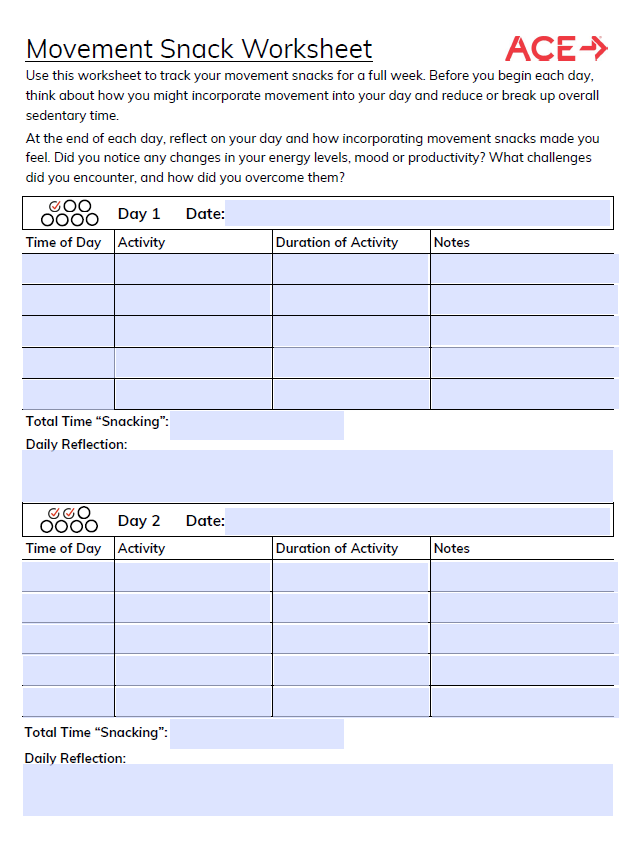|
Key Takeaways Movement snacks—short bouts of physical activity to break up sedentary behavior—are an effective way to drive important health and wellness benefits. The benefits of movement snacks include everything from reducing the risk of obesity and heart disease to better managing stress and improving mood and cognition. Learn how to empower clients to incorporate movement snacks into their daily routine and build healthy habits. This blog includes a worksheet that you can use with your clients to introduce this concept and make the most out of this important type of physical activity. |
Movement snacks are short, quick bursts of physical activity designed to break up sedentary behavior throughout the day. They're like bite-sized portions of exercise that can be easily integrated into daily routines. These brief periods of movement offer numerous benefits for both physical and mental health, making them valuable additions to anyone's lifestyle. Read on to learn more about the benefits of movement snacks and download a movement snacks worksheet.
Benefits of Movement Snacks
Our sedentary lifestyles do not do us any favors when it comes to maintaining and/or improving health metrics. Many clients spend long hours sitting at desks or in front of screens, and movement snacks offer a way to combat the negative effects of prolonged sitting—and increase the number of calories burnt outside of any exercise time.
By incorporating short bursts of activity into the day, individuals can improve circulation, boost energy levels, enhance focus and reduce the risk of various health issues associated with prolonged sitting, such as obesity, heart disease and musculoskeletal problems. Additionally, movement snacks can help improve cognition and mood, increase aerobic capacity, muscle strength, and energy metabolism and reduce stress by releasing endorphins and promoting relaxation.
Encouraging Movement Snacking
As a health and exercise professional, you play a crucial role in encouraging your clients to integrate movement snacks into their daily routines. Here are a few ways to integrate this technique.
-
Education: Provide information about the benefits of movement snacks and the risks of prolonged sitting. Help clients understand that even brief bouts of activity can make a significant difference in their overall health and well-being.
-
Personalized Recommendations: Tailor movement snack suggestions to fit each client's lifestyle, preferences and fitness level. Offer a variety of options, such as stretching exercises, short walks, “deskercises” or quick body-weight workouts.
-
Strategic Placement of Exercise Tools: Encourage clients to place exercise tools such as a jump rope, kettlebell, yoga mat or other small pieces of equipment in visible places in their house. Each time they get up to move, they are more likely to see the tool and have it serve as a reminder to perform a movement snack.
-
Goal Setting: During goal setting with clients, work to incorporate movement snacks into their daily schedule. Encourage them to start small and gradually increase the frequency and duration of their movement breaks over time.
-
Accountability and Support: Check in regularly with clients to track their progress and offer encouragement and support. Provide tips for overcoming common barriers, such as time constraints or lack of motivation, and celebrate their successes along the way.
 |
By promoting the integration of movement snacks into your clients' daily lives, you can help improve their overall health and well-being. To support your clients, use this downloadable worksheet as a tracking tool: Movement Snack Worksheet. At the end of each week, review your clients’ efforts and discuss observed patterns and progress.
|




 by
by 




 by
by